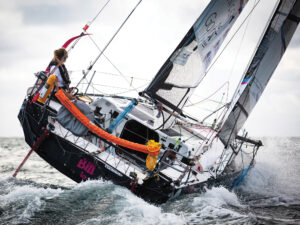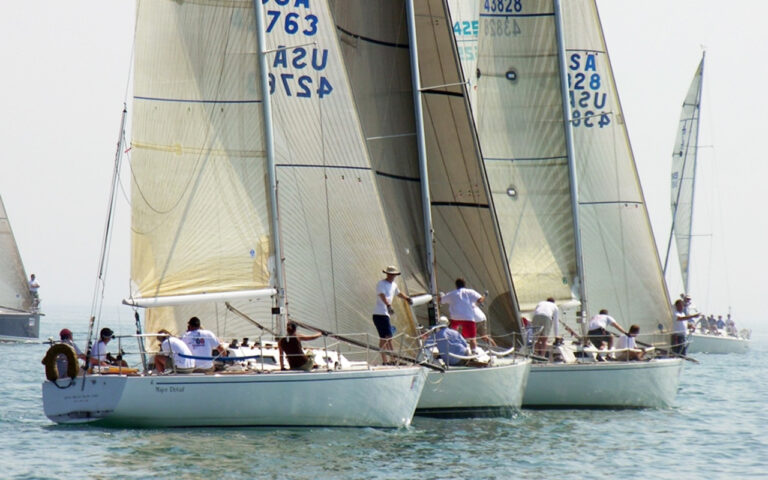
You know you’ve had a bad start when you can’t execute the game plan determined before the race. Two critical things must happen if you wish to recover: the helmsman has to sail the boat as fast as possible while in dirty air, and you need to decide where to go to get clean air.
To go fast in the second row takes power, because there is less wind and more chop in the wake of the first row. This means the backstay and cunningham must be eased, and the leads moved forward for a fuller headsail. Depending on how you decide to escape from your nightmare, the sheets should be trimmed for footing or pointing. The most common escape begins with a session of prolonged pinching, so make sure the traveler is all the way to weather and the sheets trimmed a click tighter. But be careful, a common mistake is to overtrim off the starting line.
After the boat is going as fast as possible, the burden falls on the tactician to find a clear lane to tack into. Think realistically; you are in a position where there is plenty of disturbed air and confused seas. The goal is to find a lane you can live with for at least 2 minutes. You may have to settle for a lane that gets you going the right way, but limits you to either a pinching or a footing mode.
Before you tack for clearer air, make sure no one will tack on your wind. (If they do, the dreaded ping pong match in the middle of the course will begin and, five tacks later, you’ll be 3 minutes behind.) Look at the boats to windward for any crew movement. If you see a genoa trimmer to leeward, or a tactician tailing a runner, chances are they’re about to tack. Wait for them to actually push the helm over before you tack — if you go too early, they’ll tack on you. The bottom line is: take a good hard look at the boats around you before you clear out.
RELATED: Here’s Why the Long Tack is a Winning Move for Sailors
OK, you are finally able to tack. Now where do you go? Sticking to your game plan after a bad start is tough. Once you have a clear lane, the tactician must evaluate whether the predetermined game plan is working. For example, if the plan was to go left for the first part of the beat, but a bad start has forced you onto port tack, take 30 seconds to look at the fleet to determine if the boats that went left are actually gaining. If they are, get back to your plan. If not, revise the plan.Let’s go back to the starting line and break it down into three sections. In each section, clearing out after a bad start requires the same basic principles mentioned above, but for each scenario you can use specific actions to get back on track.
The Weather End
The obvious way out of a bad start near the weather end is to tack to the right immediately. The closer you are to the weather end, the thinner the traffic blocking your path to clear air. A tack just after the start is not without danger, however. Be wary of starboard tackers who are restarting — they have rights.
Another common boat-end mistake after “pulling the trigger” too early is to delay your restart. If you know you are going to be over, get your boat moving fast, tack around the committee boat and restart. Chances are you won’t be far behind, and all the people who have bad starts right in front of you will clear out, leaving you a lane.
The Middle
I often start in the middle of the line to avoid heavy traffic at the ends. Normally, bad starts here happen when you’re late and you let a leeward boat turn up and start before you. The leeward boat instantly establishes a leebow position which will eventually affect your air. Patience is key in this situation. If you can hang in your lane until the second-row boats on your weather hip tack and clear, a lane to the right will open, allowing for a clearing tack. To “hang” with a boat, on your lee bow (and probably another slowly driving over you to weather) you must pinch the boat, picking an angle that maintains a sliver of clear air for as long as possible. Don’t foot off below the boat on your lee bow, and don’t tack away too early. If you tack too early, you’ll end up dipping the boat to weather, who may then tack on your air and begin a ping-pong match.
Another option —definitely the more dangerous of the two — becomes available when you have 10 seconds to go and realize you’re destined for a bad start. Bail out by tacking onto port and sailing against the grain before boats in the second row realize they are the second row, and find yourself a hole to cut through the mass of starboard tackers. This is fraught with danger; however, big danger can lead to big rewards. The helmsman bears full responsibility, as the tactician can’t move the starboard tackers out of the way.
Leeward End
Bailing out at the leeward end is tough, for obvious reasons. Clearing out to the immediate right is not an option as the majority of the fleet will be blocking your path. If your game plan calls for heading left, you need to assess how much dirty air you are willing to sail through to get there. If you decide to stay on starboard, crack your sheets and start reaching for clear air. Hopefully, the early loss will be forgotten when the wind shifts left. Reaching for clear air will only work when you are five (or fewer) boats up from the pin. If there are more than five boats, you will reach for eternity and clear air will never appear.
This is when you are forced to bail out. The same principles we discussed earlier apply here: be patient, wait for the proper clear lane to the right, and keep the boat moving as fast as possible. However, instead of looking for a lane you can live with for two minutes, all you need is a short lane that can take you to an area where there’s a break in the line of starboard tackers. From there, you can look for another lane to tack back to the left.









